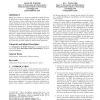118
Voted
HRI
2007
ACM
15 years 4 months ago
2007
ACM
Research on spatial cognition and navigation of the visually impaired suggests that vision may be a primary sensory modality that enables humans to align the egocentric (self to o...
111
Voted
HRI
2007
ACM
15 years 4 months ago
2007
ACM
Efforts are underway to make it possible for a single operator to effectively control multiple robots. In these high workload situations, many questions arise including how many r...
99
Voted
HRI
2007
ACM
15 years 4 months ago
2007
ACM
This paper reports a method that uses humanoid robots as a communication medium. There are many interactive robots under development, but due to their limited perception, their in...
92
Voted
HRI
2007
ACM
15 years 4 months ago
2007
ACM
We present a new technique for human-robot interaction called robot expressionism through cartooning. We suggest that robots utilise cartoon-art techniques such as simplified and ...
HRI
2007
ACM
15 years 4 months ago
2007
ACM
HRI
2007
ACM
15 years 4 months ago
2007
ACM
In this research, we realize human telepresence by developing a
109
Voted
HRI
2007
ACM
15 years 4 months ago
2007
ACM
This paper describes a robotic system that uses dance as a form of social interaction to explore the properties and importance of rhythmic movement in general social interaction. ...
101
click to vote
HRI
2007
ACM
15 years 4 months ago
2007
ACM
The goal of the RUBI project is to accelerate progress in the development of social robots by addressing the problem at multiple levels, including the development of new scientifi...
92
Voted
HRI
2007
ACM
15 years 4 months ago
2007
ACM
It is often desirable for a human to manage multiple robots. Autonomy is required to keep workload within tolerable ranges, and dynamically adapting the type of autonomy may be us...
112
Voted
HRI
2007
ACM
15 years 4 months ago
2007
ACM
Intelligent planning algorithms such as the Partially Observable Markov Decision Process (POMDP) have succeeded in dialog management applications [10, 11, 12] because of their rob...

